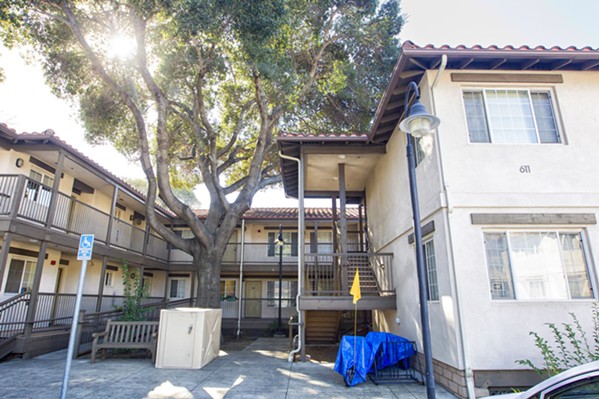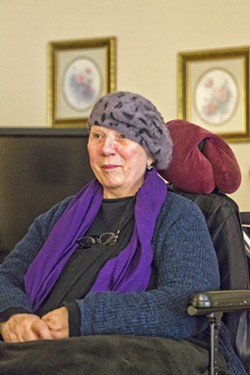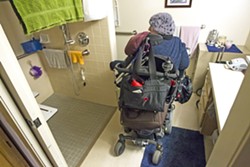Correction: This article was edited to correct the source of SunAmerica's property valuation. CB Richard Ellis was retained, not the California Bureau of Real Estate.
By all indicators, the Brizzolara Apartments in San Luis Obispo are prime downtown residential real estate. Buffered four blocks from the hustle and bustle of Higuera Street, the two two-story Spanish-style buildings with 30 units border the scenic SLO Creek across from Mission Prep High School.
Several towering eucalyptuses and one massive oak shade the complex's central courtyard. Laughter emanates from the nearby school soccer field as tree limbs gently swoosh in the wind.

- Photo By Jayson Mellom
- OWNERSHIP DISPUTE The Housing Authority of SLO (HASLO) filed for eminent domain in court on Nov. 30 to take ownership of the Brizzolara Apartments in SLO, a 30-unit affordable housing complex where 97 percent of the tenants have disabilities.
This is a special place to Anne Ramirez, 69, who's been a tenant at the Brizzolara Apartments since they first opened in 2000. Seated in her electric wheelchair on a chilly winter day, Ramirez wears a purple beret and is shrouded in blankets as she scoots down an access ramp from her one-bedroom apartment to the courtyard.
"I come out here to read magazines and books with these lovely eucalyptus trees," Ramirez said with a smile.
Like almost every resident in the Brizzolara Apartments, Ramirez is a senior with a disability. She was diagnosed with multiple sclerosis more than 25 years ago after she started falling frequently (though now, doctors aren't sure exactly what she has).
"I would be standing doing dishes and all of a sudden my legs would give out and I'd be kissing the floor," Ramirez said. "It was not a fun thing."
Physically debilitated, Ramirez searched for many years for housing that was both affordable and wheelchair-friendly. In 1998, Ramirez caught wind of the Brizzolara Apartments, a Housing Authority of San Luis Obispo (HASLO) project that was under construction at the time.
The complex was designed for disabled seniors, it was centrally located close to medical services, and the monthly rent was less than $300—it met all of her needs. Ramirez moved in on opening day and 18 years later, she hopes it will be her forever home.
"Why leave?" she asked, while gazing pleasantly around the courtyard.
But the tranquility at the Brizzolara Apartments doesn't extend beyond its courtyard and appreciative residents. While Ramirez and her neighbors envision long-term futures at the apartments, a battle is escalating over ownership of the property.
HASLO recently filed for eminent domain in SLO County Superior Court to force a purchase of the property, fearing that the land's private investor has less than benevolent intentions. The Brizzolara Apartments house just 30 of the hundreds of affordable housing units across the state that could also be impacted by the alleged actions of the investor, global insurance giant American International Group (AIG).
Trouble looming
Like most affordable housing projects nationwide, the Brizzolara Apartments were developed using Low Income Housing Tax Credits, a Reagan-era program encouraging private investment in affordable housing.

- Photo By Jayson Mellom
- HEADED TO COURT HASLO and private investor SunAmerica, an arm of American International Group (AIG), are in an ownership dispute over the Brizzolara Apartments. HASLO believes SunAmerica intends to convert the complex into market-rate housing when an affordability requirement expires in 2029, while AIG claims it's looking to sell the property.
In 1998, SunAmerica, a subsidiary of AIG and one of the top affordable housing syndicators in the U.S., invested in the Brizzolara Apartments, receiving $118,004 in annual tax credits in return, according to state records.
"That's what entices them to fund projects like this," said Jerry Rioux, executive director of the SLO Housing Trust Fund, which provides low-interest loans to local affordable housing developers. "The investor gets tax credits and [HASLO] gets money to make the project pencil."
HASLO formed a limited partnership with SunAmerica for the project where SunAmerica owned a 99.9 percent stake. Under a regulatory agreement, the complex has a 30-year affordability period to serve senior/disabled households earning 50 to 60 percent of the area median income.
Today, 97 percent of Brizzolara tenants are disabled and 70 percent are seniors earning a median income of $12,000 per year.
But HASLO is worried about what will happen to the property when the mandated period of affordability expires.
According to HASLO Executive Director Scott Smith, SunAmerica expressed an intention to convert the Brizzolara Apartments to market-rate housing in 2029, when the land is no longer deed-restricted as affordable.
"In markets that start to appreciate, like SLO, they see bigger horizons," Smith told New Times.
In a written statement to New Times, SunAmerica's parent company, AIG, denied such plans, and stated they are looking instead at "marketing" the property to "other affordable housing investors." They added that HASLO would have a contractual right of first refusal on any sale.
Smith said AIG's statement was "inconsistent with everything that they have represented thus far."
In the fine print
It's not just the future expiration of Brizzolara Apartments' deeded affordability that makes HASLO concerned.
SunAmerica has taken a series of other actions since 2015 that's made the partnership "not tolerable," according to Smith.
In 2015, SunAmerica purchased the remaining tax-exempt debt owed on the property—becoming the de facto lender as well as the owner—and raised the interest rate from 6 to 10 percent.
When HASLO asked for an explanation, SunAmerica pointed to a clause in the original bond indenture signed in 1998. Written into the fine print was a provision that allowed SunAmerica to set the interest rate at 10 percent if it became the sole holder of the bonds.
"When they did that to us we called the bond counsel that we currently use and said, 'Is this legal?'" Smith said. "He got ahold of the documents and said, 'Believe it or not, it's in there.'"
When HASLO asked if the partners would refinance the property with a different lender offering 4 percent interest, SunAmerica declined, Smith said.
In addition to now paying an interest rate more than double market rate off the tenants' backs, Smith said the buildings' foundations are due for "major" repairs because of their proximity to SLO Creek, but SunAmerica has allegedly been slow to address the issue and secure financing.
"It's not sustainable long-term," Smith said of the partnership.

- Photo By Jayson Mellom
- LONG ROAD TO HOUSING Anne Ramirez, 69, suffers from a condition resembling multiple sclerosis. Finding consistent housing was a struggle for her until she moved into the Brizzolara Apartments in 2000. She's lived happily there ever since.
SunAmerica's 10 percent interest rate didn't just affect HASLO. According to the 1998 bond documents, the rate applied to four other affordable housing projects around California with SunAmerica as the investor. The five projects—Brizzolara included—were financed together in the same $14 million bond pool.
While SunAmerica received $818,466 total in annual federal tax credits for the five projects, at least one of the complexes in the city of Roseville—Maidu Village II, which has 82 affordable units—could face foreclosure since the local nonprofit partner, Project Go, can't afford the new interest rate, according to Smith, who's spoken with Project Go staff in Roseville.
Project Go did not return phone calls from New Times by press time.
If an affordable housing complex goes into foreclosure, it's possible that the affordability requirement would lift, said Rioux of the SLO Housing Trust Fund.
"If they foreclose, and they own the mortgage, then the property is free of the deed restriction," Rioux said.
The other projects included in the bond pool are the Gable Apartments (64 affordable units) in Vacaville; the Aldea Park Apartments (40 units) in Lost Hills; and the College Park Apartments (53 units) in Dinuba.
HASLO's domain
Amid the turmoil in the partnership, HASLO and SunAmerica started negotiating a price in 2017 for the Brizzolara Apartments. But negotiations reached an "impasse," according to HASLO, when the two parties couldn't agree on the property's value.
HASLO retained property appraiser Brad Weinberg of Novogradac & Company LLP, who valued the apartments at $1.9 million. SunAmerica then produced a valuation from CB Richard Ellis, a real estate marketing firm, that valued it at $3.2 million.
HASLO refused that offer, calling the counteroffer a "business report" that had "various defects, including an artificially low capitalization rate."
Neither side would budge, so on Nov. 16, the HASLO board voted unanimously to file for eminent domain in SLO County Superior Court to force a sale of the apartments to HASLO for public use.
To HASLO, losing the Brizzolara Apartments as senior housing would be a crushing blow to an already sparse inventory of affordable units. The city of SLO needs to build 666 new affordable housing units by 2019, according to the housing element of the city's general plan.
"The loss of the subject 30 units to market rents would be substantial," Smith wrote in a memo to the HASLO board on Nov. 16. "The acquisition of the property would ensure that the disadvantaged and disabled seniors who inhabit the property will be able to maintain their residency in perpetuity."
Eminent domain allows a public agency to ask the court to compel the sale of private property for a public purpose. In the realm of affordable housing, though, it's a relatively uncommon practice.
"It is a tool, but not a popular tool," said John Fowler, president of Peoples' Self-Help Housing, an affordable housing developer on the Central Coast.
But it's not unprecedented, according to Todd Amspoker, HASLO's attorney in the case. Amspoker, an eminent domain lawyer for 30 years, said he's represented other housing authorities on affordable housing cases that ended in settlements. HASLO is a public entity with the power of eminent domain, he said.
"Housing authorities have the power to acquire property for affordable housing," Amspoker told New Times. "It's in state law and it's not really a principle that can be disputed."
Smith said HASLO is in a fortunate position to be able to take that route as a public agency. Nonprofit housing groups like Project Go in Roseville wouldn't have that ability.
"We have certain authorities that others don't have," Smith said. "And we have huge community support and the fact that all cities in this county have named affordable housing a priority."
Responding to the eminent domain filing in court on Jan. 25, SunAmerica attorneys wrote that HASLO's action was a "gross use of discretion ... based on unfounded and incorrect allegations made at the [HASLO board] hearing on the resolution of necessity."
In AIG's statement to New Times, the company said, "we look forward to having these issues promptly adjudicated."
AIG added: "This disagreement has little impact on residents of the apartments, whose homes will remain subject to the rules and regulations governing affordable housing for at least the next 12 years."
Different world today
In some ways, the dispute over the Brizzolara Apartments is a symptom of old loopholes in the affordable housing market regulations that have since been plugged.
Today, per California state law, affordability agreements are required to be 55 years, not 15 or 30 years.
"The state moved it partly for this reason," Fowler of Peoples' Self-Help Housing said. "It was a different world then."
In addition, the IRS requires that the nonprofit partner in an affordable housing project be given the right of first refusal to purchase the property at the end of the 55 years, for the amount of the remaining balance of debt on the property.
Nonprofit housing organizations have also become savvier negotiators to avoid precarious power struggles with their investors. HASLO's current policy in any new affordable housing project is to retain ownership of the underlying land and lease it to the investor on the condition that the property stays affordable.

- Photo By Jayson Mellom
- ACCESSIBLE HOME Ramirez showed New Times her wheelchair-accessible one-bedroom apartment, which she pays less than $300 in rent for. The Housing Authority of SLO recently filed for eminent domain to purchase the Brizzolara Apartments from AIG investors.
But issues remain. With the high value of Central Coast real estate, investors frequently try to get more out of an affordable housing project than the tax credits, Fowler said.
"We haven't had to pay yet, but we've gotten in a lot of arguments and discussions," he said. "Investors want a piece of it when they walk away."
Affordable housing advocates are also worried about a potential dip in the production of new units due to President Donald Trump's tax reform bill. As corporate tax rates are slashed in the legislation, investors have less incentive to participate in the Low Income Housing Tax Credits program.
"The value of tax credits have dropped because fewer investors need the tax credit," Rioux said. "The demand is down, so the value of the tax credits has dropped."
Needing homes
Ramirez, the Brizzolara tenant, is well acquainted with the uncertainty of keeping a roof over her head. When she lived in Southern California, she exhausted every effort to find accessible, affordable housing before moving in with her son in SLO.
Finding the Brizzolara Apartments was a "prayer answered," she said. She can attend Thursday Farmers' Markets. Get to her doctors' appointments without trouble. Go shopping. And, yes, read books in the courtyard.
"That's why affordable housing is so important," Ramirez said. "It impacts so many people's lives, mine included."
If the apartments became market rentals, none of the current Brizzolara tenants could live there anymore.
"Every person here would have to move out," Ramirez said.
As HASLO tries to preserve the apartments as affordable to disabled seniors for the long haul, Patricia Souza, the senior tenant representative to the HASLO board, said she knows there are many more in SLO County who also need places to live.
"I know there's a lot of people out there that still need help, especially our seniors and veterans," Souza said. "We need more." Δ
Staff Writer Peter Johnson can be reached at [email protected].
Comments